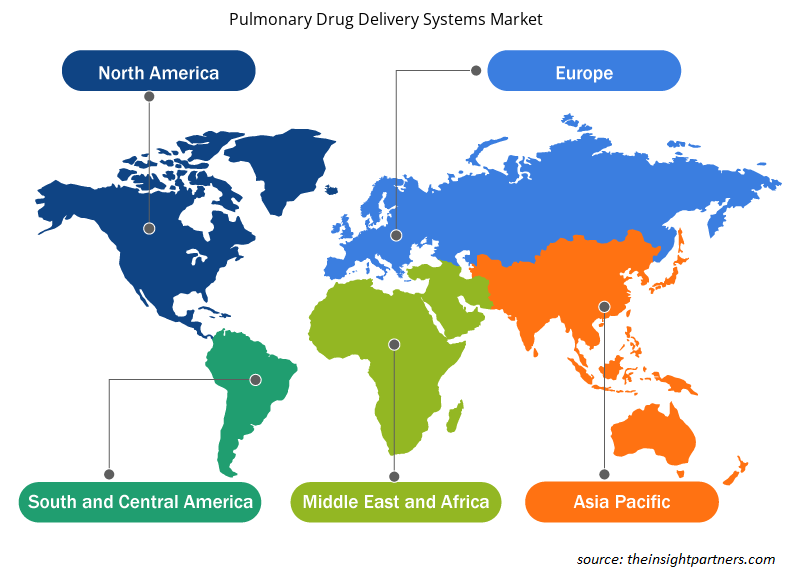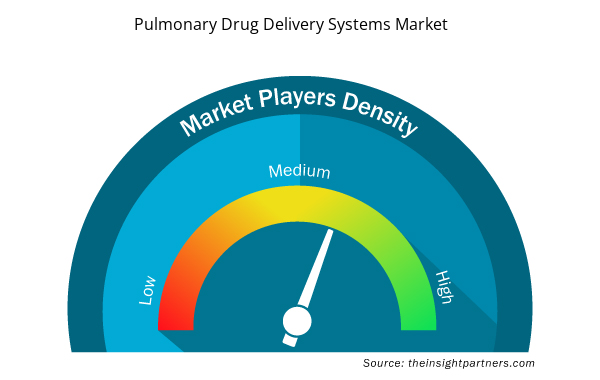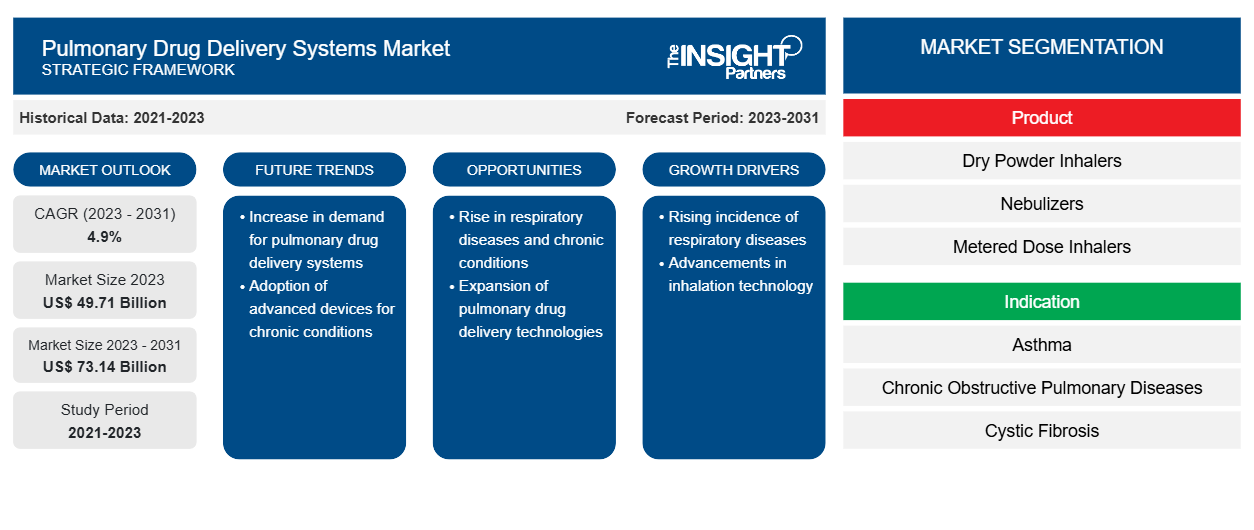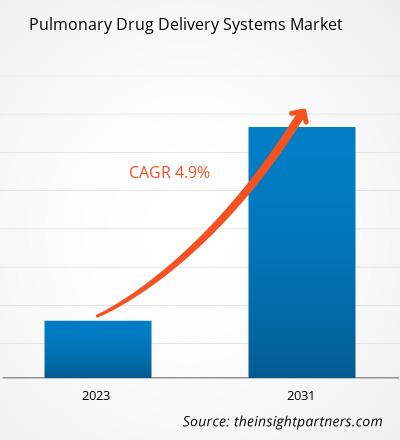[研究报告] 肺部药物输送系统市场规模预计将从 2023 年的 497.1 亿美元增至 2031 年的 731.4 亿美元;预计 2023-2031 年期间的复合年增长率为 4.9%。
市场洞察和分析师观点:
肺部给药系统用于通过吸入将气溶胶直接输送到上皮细胞和呼吸道上皮。该系统包括吸入器和雾化器等设备,用于将药物输送到肺部以治疗患有呼吸系统疾病的患者。肺部给药设备基于不同的输送机制,包含各种药物配方。哮喘、慢性阻塞性肺病 (COPD)、急性呼吸道感染、过敏性鼻炎和囊性纤维化是需要使用给药设备的主要呼吸系统疾病。呼吸系统疾病负担的增加和公司不断增加的战略举措有利于肺部给药系统市场的增长。肺部给药系统市场趋势包括吸入器技术的进步,这将有利于未来市场的增长。
增长动力:
在肺部药物输送系统市场运营的公司不断关注战略发展,例如合作、协议、伙伴关系和新产品发布。这些策略有助于他们提高销售额、扩大地理覆盖范围并增强服务现有客户群的能力。新产品的发布主要是为了提高安全性、提供用户友好功能、提供更好的剂量能力等,以吸引大量患者。以下是肺部药物输送系统市场的一些值得注意的发展:
- 2021 年 9 月,BreatheSuite Inc. 获得了美国食品药品监督管理局 (FDA) 对其 BreatheSuite 定量吸入器 V1 设备的 510(K) 批准,可用于处方和非处方用途。BreatheSuite V1 可自动准确地监测哮喘和 COPD 患者的吸入器依从性和技术,并为其提供反馈,从而将现有的定量吸入器转变为智能吸入器。
- 2021年6月,Glenmark Pharmaceuticals Ltd 在英国推出了 Tiogiva,这是噻托溴铵干粉吸入器的生物等效版本,用于治疗 COPD。
- 2021 年 4 月,KINDEVA DRUG DELIVERY 与 Cambridge Healthcare Innovations Limited (CHI) 合作开发和商业化 CHI 的 αeolus 干粉吸入器 (DPI) 平台技术。
- 2020 年 12 月,创新数字医疗公司 AireHealth 的联网雾化器获得了 510(k) 许可。该设备是一种便携式电子振动网状雾化器。它旨在将液体药物雾化以供患者吸入。它以 VitalMed 品牌销售。
- 2020 年 9 月,葛兰素史克公司和 Innoviva 公司获得 FDA 批准,将 Trelegy Ellipta 作为美国首个每日一次的单吸入器三联疗法,用于治疗美国 18 岁及以上的哮喘和 COPD 患者。
因此,为了保持市场竞争力,公司不断增加的战略发展和产品发布推动了肺部药物输送系统市场的增长。
定制此报告以满足您的需求
您可以免费定制任何报告,包括本报告的部分内容、国家级分析、Excel 数据包,以及为初创企业和大学提供优惠和折扣
- 获取此报告的关键市场趋势。这个免费样品将包括数据分析,从市场趋势到估计和预测。
报告细分和范围:
肺部给药系统市场分析考虑了以下几个部分:产品、适应症、分销渠道、最终用户和地理区域。就产品而言,市场分为干粉吸入器、雾化器和定量吸入器。根据适应症,市场分为慢性阻塞性肺病、哮喘、囊性纤维化等。根据分销渠道,市场分为医院药房、零售药房和电子商务。根据最终用户,市场分为医院和诊所以及家庭护理。肺部药物输送系统市场报告的范围涵盖北美(美国、加拿大和墨西哥)、欧洲(法国、德国、英国、西班牙、意大利和欧洲其他地区)、亚太地区(中国、日本、印度、韩国、澳大利亚和亚太其他地区)、中东和非洲(沙特阿拉伯、南非、阿联酋和中东和非洲其他地区)以及南美洲和中美洲(巴西、阿根廷和南美洲和中美洲其他地区)。
节段分析:
肺部给药系统市场按产品分为干粉吸入器、雾化器和定量吸入器。干粉吸入器细分市场在 2023 年占据了相当大的市场份额。预计在 2023-2031 年期间,它将创下市场最高复合年增长率。
就适应症而言,肺部给药系统市场分为慢性阻塞性肺病、哮喘、囊性纤维化等。慢性阻塞性肺病领域在 2023 年占据了相当大的市场份额,预计在 2023-2031 年期间将实现最高的复合年增长率。
根据分销渠道,市场分为医院药房、零售药房和电子商务。2023 年,医院药房部门占据了肺部药物输送系统市场的重要份额。电子商务部门预计在 2023-2031 年期间的复合年增长率最高。
根据最终用户,肺部给药系统市场分为医院和诊所以及家庭护理。医院和诊所部门在 2023 年占据了相当大的市场份额。预计家庭护理部门在 2023-2031 年期间的复合年增长率会更高。
区域分析:
从地理上看,肺部给药系统市场分为北美、欧洲、亚太地区、南美和中美以及中东和非洲。2023 年,北美占据了相当大的市场份额。2023 年,美国占据了该地区最大的市场份额。北美市场的增长归因于哮喘、慢性阻塞性肺病等呼吸系统疾病发病率的上升;老年人口的增加;对诊断设备的需求不断增长;以及主要市场参与者的强大影响力。根据美国疾病控制和预防中心 (CDC) 的数据,2020 年,美国约有 5.0% 的成年人被诊断患有 COPD 或慢性支气管炎。约有 2500 万人患有哮喘,1480 万人患有 COPD。此外,加拿大护士协会估计,加拿大约有 300 万人患有严重的呼吸系统疾病,如 COPD、囊性纤维化、哮喘和职业性肺病。
根据加拿大肺脏协会的数据,呼吸系统疾病是住院人数第三多的疾病,加拿大约有五分之一的人患有严重的呼吸系统疾病,如哮喘、慢性阻塞性肺病、肺癌、肺结核、囊性纤维化和呼吸窘迫综合征。患有各种呼吸系统疾病的患者数量不断增加,推动了对创新有效的肺部药物输送系统(如定量吸入器或雾化器)的需求。
肺部药物输送系统市场区域洞察
Insight Partners 的分析师已详尽解释了预测期内影响肺部药物输送系统市场的区域趋势和因素。本节还讨论了北美、欧洲、亚太地区、中东和非洲以及南美和中美洲的肺部药物输送系统市场细分和地理位置。

- 获取肺部药物输送系统市场的区域特定数据
肺部药物输送系统市场报告范围
| 报告属性 | 细节 |
|---|---|
| 2023 年的市场规模 | 497.1亿美元 |
| 2031 年市场规模 | 731.4亿美元 |
| 全球复合年增长率(2023 - 2031) | 4.9% |
| 史料 | 2021-2023 |
| 预测期 | 2023-2031 |
| 涵盖的领域 | 按产品
|
| 覆盖地区和国家 | 北美
|
| 市场领导者和主要公司简介 |
|
肺部给药系统市场参与者密度:了解其对业务动态的影响
肺部给药系统市场正在快速增长,这得益于终端用户需求的不断增长,而这些需求又源于消费者偏好的不断变化、技术进步以及对产品优势的认识不断提高等因素。随着需求的增加,企业正在扩大其产品范围,进行创新以满足消费者的需求,并利用新兴趋势,从而进一步推动市场增长。
市场参与者密度是指在特定市场或行业内运营的企业或公司的分布情况。它表明在给定市场空间中,相对于其规模或总市场价值,有多少竞争对手(市场参与者)存在。
在肺部药物输送系统市场运营的主要公司有:
- 阿斯利康
- 葛兰素史克公司
- 诺华公司
- 荷兰皇家飞利浦公司
- 勃林格殷格翰国际有限公司
免责声明:上面列出的公司没有按照任何特定顺序排列。

- 了解肺部药物输送系统市场的主要参与者概况
行业发展和未来机遇:
肺部药物输送系统市场报告包括公司定位和集中度,以评估市场中竞争对手的表现。根据公司新闻稿,以下是市场中主要参与者采取的一些举措:
- 2021 年 3 月,PARI Pharma GmbH 获得 LAMIRA 雾化器系统的授权,用于在日本输送 Insmed 的药品 ARIKAYCE(阿米卡星脂质体吸入混悬液)。2021 年 3 月,Insmed 获得了日本厚生劳动省对 ARIKAYCE 的批准。ARIKAYCE 在日本的批准是继美国和欧洲先前获得批准之后的又一举措。
- 2020 年 12 月,欧盟委员会批准阿斯利康的 Trixeo Aerosphere 在欧盟用于治疗 COPD。该药物用于治疗患有中度至重度 COPD 的成年患者。Trixeo Aerosphere 是一种单吸入器、固定剂量三联药物,由富马酸福莫特罗、格隆溴铵、布地奈德和吸入性皮质类固醇组成,通过加压定量吸入器输送。
竞争格局和重点公司:
肺部药物输送系统市场预测可以帮助利益相关者规划其增长战略。阿斯利康、葛兰素史克、诺华、荷兰皇家飞利浦、勃林格殷格翰国际有限公司、西普拉公司、欧姆龙公司、PARI GmbH、Glenmark Pharmaceuticals 和 Gilbert Technologies 是该市场的主要参与者。这些公司专注于推出新的高科技产品、改进现有产品和扩大地域范围,以满足全球日益增长的消费者需求。
- 历史分析(2 年)、基准年、预测(7 年)及复合年增长率
- PEST 和 SWOT 分析
- 市场规模价值/数量 - 全球、区域、国家
- 行业和竞争格局
- Excel 数据集



Report Coverage
Revenue forecast, Company Analysis, Industry landscape, Growth factors, and Trends

Segment Covered
This text is related
to segments covered.

Regional Scope
North America, Europe, Asia Pacific, Middle East & Africa, South & Central America

Country Scope
This text is related
to country scope.
常见问题
The factors driving the growth of the pulmonary drug delivery systems market include the increasing burden of respiratory diseases and growing strategic initiatives by companies. However, regulatory issues associated with the approval of pulmonary drug delivery systems hampers the growth of the pulmonary drug delivery systems market.
The global pulmonary drug delivery systems market is segmented based on product, indication, distribution channel, and end user. The pulmonary drug delivery systems market, by product, is categorized into dry powder inhalers, nebulizers, and metered dose inhalers. The dry powder inhalers segment held a significant market share in 2023 and is anticipated to record the highest CAGR in the market during 2023–2031.
The pulmonary drug delivery systems market was valued at US$ 49.71 billion in 2023.
The pulmonary drug delivery systems market is expected to be valued at US$ 73.14 billion in 2031.
The pulmonary drug delivery systems market majorly consists of the players, including AstraZeneca, GlaxoSmithKline Plc, Novartis AG, Koninklijke Philips NV, Boehringer Ingelheim International GmbH, Cipla Inc., OMRON Corp., PARI GmbH, Glenmark Pharmaceuticals, and Gilbert Technologies.
Pulmonary drug delivery refers to the systems that target the delivery of aerosols directly to epithelial cells and respiratory epithelium through inhalation. These systems deliver the drug to the lungs to treat respiratory diseases. It is one of the most preferred drug delivery routes and a noninvasive technique with a large surface area of absorption and blood circulation.
Trends and growth analysis reports related to Life Sciences : READ MORE..
The List of Companies - Pulmonary Drug Delivery Systems Market
- AstraZeneca
- GlaxoSmithKline Plc
- Novartis AG
- Koninklijke Philips NV
- Boehringer Ingelheim International GmbH
- Cipla Inc
- OMRON Corp.
- PARI GmbH
- Glenmark Pharmaceuticals
- Gilbert Technologies
The Insight Partners performs research in 4 major stages: Data Collection & Secondary Research, Primary Research, Data Analysis and Data Triangulation & Final Review.
- Data Collection and Secondary Research:
As a market research and consulting firm operating from a decade, we have published and advised several client across the globe. First step for any study will start with an assessment of currently available data and insights from existing reports. Further, historical and current market information is collected from Investor Presentations, Annual Reports, SEC Filings, etc., and other information related to company’s performance and market positioning are gathered from Paid Databases (Factiva, Hoovers, and Reuters) and various other publications available in public domain.
Several associations trade associates, technical forums, institutes, societies and organization are accessed to gain technical as well as market related insights through their publications such as research papers, blogs and press releases related to the studies are referred to get cues about the market. Further, white papers, journals, magazines, and other news articles published in last 3 years are scrutinized and analyzed to understand the current market trends.
- Primary Research:
The primarily interview analysis comprise of data obtained from industry participants interview and answers to survey questions gathered by in-house primary team.
For primary research, interviews are conducted with industry experts/CEOs/Marketing Managers/VPs/Subject Matter Experts from both demand and supply side to get a 360-degree view of the market. The primary team conducts several interviews based on the complexity of the markets to understand the various market trends and dynamics which makes research more credible and precise.
A typical research interview fulfils the following functions:
- Provides first-hand information on the market size, market trends, growth trends, competitive landscape, and outlook
- Validates and strengthens in-house secondary research findings
- Develops the analysis team’s expertise and market understanding
Primary research involves email interactions and telephone interviews for each market, category, segment, and sub-segment across geographies. The participants who typically take part in such a process include, but are not limited to:
- Industry participants: VPs, business development managers, market intelligence managers and national sales managers
- Outside experts: Valuation experts, research analysts and key opinion leaders specializing in the electronics and semiconductor industry.
Below is the breakup of our primary respondents by company, designation, and region:

Once we receive the confirmation from primary research sources or primary respondents, we finalize the base year market estimation and forecast the data as per the macroeconomic and microeconomic factors assessed during data collection.
- Data Analysis:
Once data is validated through both secondary as well as primary respondents, we finalize the market estimations by hypothesis formulation and factor analysis at regional and country level.
- Macro-Economic Factor Analysis:
We analyse macroeconomic indicators such the gross domestic product (GDP), increase in the demand for goods and services across industries, technological advancement, regional economic growth, governmental policies, the influence of COVID-19, PEST analysis, and other aspects. This analysis aids in setting benchmarks for various nations/regions and approximating market splits. Additionally, the general trend of the aforementioned components aid in determining the market's development possibilities.
- Country Level Data:
Various factors that are especially aligned to the country are taken into account to determine the market size for a certain area and country, including the presence of vendors, such as headquarters and offices, the country's GDP, demand patterns, and industry growth. To comprehend the market dynamics for the nation, a number of growth variables, inhibitors, application areas, and current market trends are researched. The aforementioned elements aid in determining the country's overall market's growth potential.
- Company Profile:
The “Table of Contents” is formulated by listing and analyzing more than 25 - 30 companies operating in the market ecosystem across geographies. However, we profile only 10 companies as a standard practice in our syndicate reports. These 10 companies comprise leading, emerging, and regional players. Nonetheless, our analysis is not restricted to the 10 listed companies, we also analyze other companies present in the market to develop a holistic view and understand the prevailing trends. The “Company Profiles” section in the report covers key facts, business description, products & services, financial information, SWOT analysis, and key developments. The financial information presented is extracted from the annual reports and official documents of the publicly listed companies. Upon collecting the information for the sections of respective companies, we verify them via various primary sources and then compile the data in respective company profiles. The company level information helps us in deriving the base number as well as in forecasting the market size.
- Developing Base Number:
Aggregation of sales statistics (2020-2022) and macro-economic factor, and other secondary and primary research insights are utilized to arrive at base number and related market shares for 2022. The data gaps are identified in this step and relevant market data is analyzed, collected from paid primary interviews or databases. On finalizing the base year market size, forecasts are developed on the basis of macro-economic, industry and market growth factors and company level analysis.
- Data Triangulation and Final Review:
The market findings and base year market size calculations are validated from supply as well as demand side. Demand side validations are based on macro-economic factor analysis and benchmarks for respective regions and countries. In case of supply side validations, revenues of major companies are estimated (in case not available) based on industry benchmark, approximate number of employees, product portfolio, and primary interviews revenues are gathered. Further revenue from target product/service segment is assessed to avoid overshooting of market statistics. In case of heavy deviations between supply and demand side values, all thes steps are repeated to achieve synchronization.
We follow an iterative model, wherein we share our research findings with Subject Matter Experts (SME’s) and Key Opinion Leaders (KOLs) until consensus view of the market is not formulated – this model negates any drastic deviation in the opinions of experts. Only validated and universally acceptable research findings are quoted in our reports.
We have important check points that we use to validate our research findings – which we call – data triangulation, where we validate the information, we generate from secondary sources with primary interviews and then we re-validate with our internal data bases and Subject matter experts. This comprehensive model enables us to deliver high quality, reliable data in shortest possible time.


 获取此报告的免费样本
获取此报告的免费样本